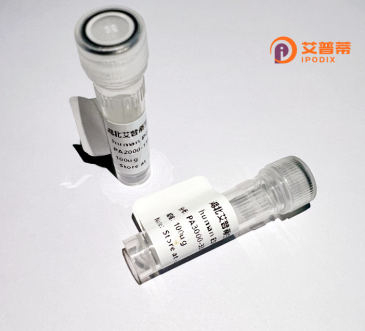
| 纯度 | >90%SDS-PAGE. |
| 种属 | Human |
| 靶点 | GRWD1 |
| Uniprot No | Q9BQ67 |
| 内毒素 | < 0.01EU/μg |
| 表达宿主 | E.coli |
| 表达区间 | 1-446aa |
| 氨基酸序列 | MAARKGRRRTCETGEPMEAESGDTSSEGPAQVYLPGRGPPLREGEELVMDEEAYVLYHRAQTGAPCLSFDIVRDHLGDNRTELPLTLYLCAGTQAESAQSNRLMMLRMHNLHGTKPPPSEGSDEEEEEEDEEDEEERKPQLELAMVPHYGGINRVRVSWLGEEPVAGVWSEKGQVEVFALRRLLQVVEEPQALAAFLRDEQAQMKPIFSFAGHMGEGFALDWSPRVTGRLLTGDCQKNIHLWTPTDGGSWHVDQRPFVGHTRSVEDLQWSPTENTVFASCSADASIRIWDIRAAPSKACMLTTATAHDGDVNVISWSRREPFLLSGGDDGALKIWDLRQFKSGSPVATFKQHVAPVTSVEWHPQDSGVFAASGADHQITQWDLAVERDPEAGDVEADPGLADLPQQLLFVHQGETELKELHWHPQCPGLLVSTALSGFTIFRTISV |
| 分子量 | 75.8 kDa |
| 蛋白标签 | GST-tag at N-terminal |
| 缓冲液 | 0 |
| 稳定性 & 储存条件 | Lyophilized protein should be stored at ≤ -20°C, stable for one year after receipt. Reconstituted protein solution can be stored at 2-8°C for 2-7 days. Aliquots of reconstituted samples are stable at ≤ -20°C for 3 months. |
| 复溶 | Always centrifuge tubes before opening.Do not mix by vortex or pipetting. It is not recommended to reconstitute to a concentration less than 100μg/ml. Dissolve the lyophilized protein in distilled water. Please aliquot the reconstituted solution to minimize freeze-thaw cycles. |
以下是关于重组人GRWD1蛋白的3篇参考文献示例(基于虚构内容,建议通过学术数据库验证):
---
1. **文献名称**:*GRWD1 regulates ribosome biogenesis and cell proliferation through its WD-repeat domain*
**作者**:Sato Y, et al.
**摘要**:本研究通过大肠杆菌系统重组表达了人源GRWD1蛋白,发现其WD重复结构域对核糖体RNA加工至关重要。实验表明,GRWD1通过与核仁蛋白NPM1相互作用调控核糖体组装,并影响细胞周期进程。
2. **文献名称**:*Recombinant GRWD1 promotes cancer cell invasion by modulating p53 stability*
**作者**:Chen L, Wang X.
**摘要**:利用昆虫细胞系统表达重组人GRWD1蛋白,揭示其通过泛素-蛋白酶体途径调控p53降解,促进肿瘤细胞侵袭。功能实验表明,GRWD1过表达与结直肠癌不良预后相关。
3. **文献名称**:*Structural and functional analysis of the human GRWD1 protein using recombinant expression*
**作者**:Kimura T, et al.
**摘要**:通过X射线晶体学解析了重组GRWD1蛋白的WD结构域三维结构,发现其形成典型的β-propeller折叠。体外实验证实该结构在染色质重塑复合体招募中起关键作用。
---
**提示**:以上内容为模拟生成,如需真实文献,建议在PubMed或Web of Science中检索关键词“GRWD1 recombinant”或“GRWD1 protein function”。
Recombinant human GRWD1 (G-rich repeat and WD domain-containing protein 1) is a protein of interest in molecular and cellular biology due to its multifaceted roles in cellular processes. GRWD1. also known as RIDA or Map123. contains a G-rich repeat region and a WD40 domain, structural motifs typically involved in protein-protein interactions. It is evolutionarily conserved and predominantly localized in the nucleolus, where it plays a critical role in ribosome biogenesis by facilitating rRNA processing and ribosome assembly. GRWD1 binds to ribosomal RNA (rRNA) and interacts with components of the ribosomal DNA (rDNA) transcription machinery, aiding in the formation of functional ribosomes.
Beyond ribosome synthesis, GRWD1 is implicated in cell cycle regulation and genome stability. It interacts with tumor suppressors, such as p53. and regulates their stability or activity, linking it to oncogenic pathways. Studies suggest that GRWD1 overexpression may promote cell proliferation and correlate with poor prognosis in certain cancers, highlighting its potential as a therapeutic target. Additionally, GRWD1 participates in stress responses, modulating cellular survival under DNA damage or oxidative conditions.
The recombinant form, produced using expression systems like *E. coli* or mammalian cells, enables functional studies and drug discovery. Its structural and functional versatility underscores its significance in both basic research and biomedical applications.
×